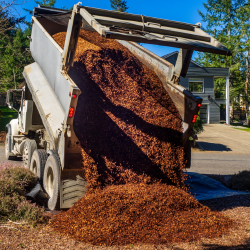Dump trucks are the one standard heavy equipment for municipal Highway and DPW operations. They are solid, heavy-momentum objects that can cause serious injuries, so their safe operation requires employees to exercise extreme caution. According to the National Institute for Occupational Safety & Health (NIOSH), 809 workers were killed in incidents involving dump trucks from 2011 to 2020 in the United States. That’s an average of 81 people killed per year while operating or working nearby dump trucks. Fortunately, there are prevention measures to protect employees.
Working near or operating a dump truck can result in struck-by hazards like back-over incidents, tip-overs from loss of vehicle control, crushing hazards including caught between, electrical hazards, and falls from the dump truck cab or dump body if proper precautions aren’t taken. Operators of dump trucks should be aware of the several sources of instability that lead to dump truck tip-overs such as:
- narrow roads,

- unstable ground unable to support the weight of the dump truck,
- longer truck beds and raised truck beds,
- improper tire pressure,
- improper loading of the truck, including loads over the rated load capacity,
- operating on slopes or uneven ground, and
- uneven or incomplete material flow out of the dump bed like clay or frozen soil.
Groundworkers should be informed of the hazards of working near operating dump trucks including:
- blind spots,
- communication difficulties,
- unexpected movement of dump trucks,
- potential lack of visibility when reversing,
- tip-overs,
- crushing hazards,
- and electrical hazards.
First, prepare and plan for safety to protect workers from the related hazards. Develop a safety program that addresses the safety hazards to drivers and groundworkers. Inspect the work area for potential hazards before and during each shift to address changing conditions. This should be done by one or more competent persons, as defined by the Occupational Safety and Health Administration (OSHA). Provide staging areas to minimize back-up distances. Lastly, eliminate or decrease the need for groundworkers near moving vehicles and provide physical barriers where necessary.
Additionally, provide training. Train drivers to recognize and prevent hazards related to operating dump trucks. Utilize internal traffic control plans and standard operating procedures for entering and exiting the work zone. Determine a safe distance from overhead hazards, particularly electrical lines. Implement emergency procedures if a truck strikes an electrical line, particularly how to safely exit a truck contacting live lines. Instruct on the steps to take when tarping and untarping the truck bed and when getting on and off equipment, including the rule of three points of contact.
Lastly, implement new technology and use proper personal protective equipment (PPE). Consider installing backup, proximity, or worksite cameras, electronic signaling devices, and proximity sensor alarms for groundworkers. High-visibility apparel should always be worn when working around operating dump trucks.
The NIOSH Fatality Assessment and Control Evaluation (FACE) program provides reports on dump truck-related deaths. For a copy of the full NIOSH report, see this link. If you have questions or concerns about dump truck safety, reach out to Robert Blaisdell at This email address is being protected from spambots. You need JavaScript enabled to view it..

